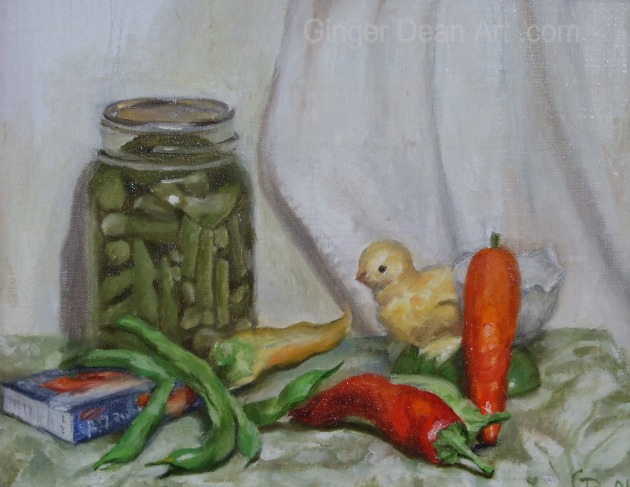Classic 70's Chick (V2)
Classic 70's chick
scent of these times
gold digger want to
be.
Poet & scholar
stuck on
T.S. Eliot “The Waste
Land.”
She tracks down a few
stray men,
prospect hunks, &
greenback dreams.
Her long legs stretched
out
beneath this dinette
table, these
high wooden heels
hang out
@ Dusty, Dingy Bar
& Grill.
She's
drenched - Charlie by Revlon 1973,
high hopes 4 sugar
daddies,
fragile body, insecure
but lean.
She wears that hot
apple, sex red, jumpsuit.
That yellow bandana hangs
around
her neck lowered downtown
below
her bosom with a grin.
Her
head stuff, insulated with cotton candy dreams
cramped
in a Chinese fortune cookie aphorism.
G-String strung up
itching @ her buttocks
positioned in spot
her world for a change.
In action verbs flow,
this dance, these
melodies,
Walt Disney world,
her magic pen, her
ink that flows.

Beans and Chick -- Ginger Dean
In 1922 T. S. Eliot published "The Waste Land," a 434-line poem, an interpretive retelling of the legend of the Fisher King, the last guardian of the Holy Grail. In all versions he is unable to stand due to a wound in his legs or groin. His personal infertility has spread to his entire domain, transforming it into a mythic Wasteland. Usually the king has been wounded by some mystical weapon (often the spear that the centurian Longinus used to pierce Jesus' side to make sure he was dead; the discharge of blood and water was regarded as a sign of his dual human/divine nature) as punishment for committing a sin. Eliot claimed that his main inspiration was Jessie Laidlay Weston's "From Ritual to Romance" (1920), which posited a mystical origin connected to self-realization.
ReplyDeleteCharles Revson founded Revlon in 1932 to market a type of nail enamel and then developed a new manufacturing process that used pigments instead of dyes to create new shades of opaque nail enamel. In 1973 he launched Charlie fragrance and aggressively promoted it with confident and fabulous "Charlie girls," including Naomi Sims (the 1st African Americam woman to be featured in cosmetics ads) and Shelley Hack and Charly Stember (the 1st to wear pants in fragrance ads). Within 3 years Charlie was the world's best selling perfume.
A sugar daddy is an older man of some means who provides a younger woman with cash, gifts, or other financial and material benefits in exchange for a sexual relationship. The term comes from a caramel candy bar on a stick (originally called the Papa Sucker) invented by chocolate salesman Robert Welch for his Oxford Candy Company in New York. His brother left Oxford to found the James O. Welch Company in 1927, and when Oxford went bankrupt during the Great Depression hired Robert. The Welch Co. changed its name to Sugar Daddy in 1932. It introduced bite-sized caramel flavored jelly beans called Sugar Babies in 1935 (the term used for the beneficiaries of the sugar daddy's favors) and a chocolate-covered Sugar Mama in 1965, after the firm company was bought up by Nabisco; "sugar mama" became the name for older women who paid to keep younger men. Welch became rich and involved in Republican Party politics. In 1958 he founded the right-wing John Birch Society to promote is conspiracy theories; in the 1960s he became persuaded that Communism itself was but "a tool of the total conspiracy" that began in Sparta and reached its final form in the "uniformly Satanic creed and program" of the Bavarian Illuminati. At its height his organization had 100,000 members and continues to exert considerable influence.
ReplyDeleteChinese fortune cookies are served as a desert in Chinese restaurants throughout the West but not in China. (In fact, they were imported to Hong Kong in 1989 as "genuine American fortune cookies.") They contain a prophecy or aphorism or a list of lucky numbers. They probably originated by combining the tradition of omikuji, random fortunes written on strips of paper at Shinto shrines and Buddhist temples in Japan, with a cookie that was popular in Kyoto. Hagiwara Makoto immigrated to the US in 1879 at 25. From a farm family, in 1895 he became responsible for the maintenance and expansion of the Japanese Tea Garden at Golden Gate Park in San Francisco, California, and began serving "fortune tea cakes" there. Kito Seiichi, who founded the Fugetsu-do restaurant in Los Angeles' Little Tokyo area in 1903, began distributing them to Chinese restaurants.
A G-string is a narrow piece of fabric, leather, or satin that covers or holds the genitals, passes between the buttocks, and is attached to a waistband around the hips. It is often worn by "exotic dancers" although it is also worn as skimpy swimwear. In 1877 John H. Beadle described the "geestring" as "a single strip of cloth ... between the limbs from front to back" worn by Native Americans to fasten their loincloths, and 14 years later "Harper's Magazine" referred to that item of clothing as a "G-string." (in 1991 Nixon speechwriter William Safire suggested that the editors had confused the term with the string for the G-note, though the narrowest string on a violin is actually the E). In the 1920s Earl Carroll, "the troubadour of the nude," introduced the concept of showgirls wearing G-strings (referred to as "gadgets").
Walt Disney was an animator who introduced "Mickey Mouse" in 1928 as "steamboat Willie" and went on to pioneer the production of sophisticated cartoons, which garnered him a record 22 Oscars from the Academy of Motion Picture Arts and Sciences. In July 1955 he opened Disneyland near Anaheim, California, which attracted 3.6 million visitors in its 1st year of operation. Since then over 700 million customers have attended. In 1971 he opened a 2nd theme park, Disney World, near Orlando, Florida, which contained a large, more elaborate version of Disneyland called the Magic Kingdom.